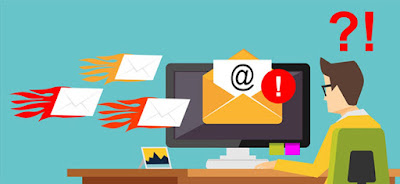WHAT IS EMAIL BOMBARDMENT?


As a result of the great impact that information technologies have had in daily life, in the workplace or for entertainment and added to the enormous advantages they offer us, these tools have become more than indispensable for a large number of people, which grows every second.
Few people or institutions currently do not have an e-mail
address, and it is no wonder, since e-mail is one of the most popular and
useful services offered to us in the wide world of the Internet.
Thanks to this service we can communicate with anyone
around the world, share all kinds of information and avoid the various
inconveniences of ordinary mail and all practically free of charge. But, if
there are millions of people making legitimate use of a service, then there
must also be a way to take advantage of it for illegitimate purposes, and that
is what has happened with email, where there are a large number of hidden
threats, which are they have increased due, among other things, to the fact
that people do not pay enough care when opening their mail, belittling or
ignoring the risks that exist.
Threats such as viruses, worms, Trojans and other
cybernetic fauna known as malware, or spam, pharming and phishing attacks, have
found a real niche for action in email. Therefore, a series of recommendations
are presented below to mitigate the risk and be able to rest easy when checking
our inbox.
Ø Have control over which people or
institutions the email account is provided to: This
address is part of our personal information and should not be spread
indiscriminately, it is also highly recommended to review the privacy policies
that each institution manages and know what they will do with our data before
providing them.
Ø Never open links: Do
not open, respond to, or click on links or download attachments that we receive
in unsolicited emails or of which the sender is unknown. As mentioned, this
medium is a gateway for the spread of malware and other threats.
Ø Ignore the strings: These
types of messages are very common and cover a significant volume of mailboxes.
In most cases, users only forward the information, causing more and more email
references to accumulate in the body of the message, which forms a rich source
of addresses for spammers, who can easily collect those using automated tools.
Ø Do not reply to spam: These
messages are mainly related to offers, advertising, notices of having won a
prize, or practically anything with the aim of attracting attention. When a
response is sent, the attacker or spammer is being confirmed that the account
is active; the main recommendation is to ignore these emails and delete them
immediately.
Ø Use Strong Passwords: Use a
password with robust security features, modifying it periodically. It is
suggested to use a minimum length of 8 characters, inserting letters, numbers
and special symbols, avoiding using personal data such as the date of birth or
the username itself. It is also important to modify it periodically in order to
protect against unauthorized access and identity theft through our email.
Ø Encrypt email: In
case it is required to preserve the confidentiality of the information, there
are solutions to encrypt our messages. Few applications work on web based mail
services like Gmail, Hotmail or Yahoo. Likewise, the clients of applications
such as Outlook or Thunderbird have their configuration options or applications
to make the encryption and decryption of information possible.
Ø Remember to log out at the end: Mainly
in public places such as computer rooms or internet cafes, it is important not
to forget to close the email session, thus avoiding that another person who
uses the same computer, is able to enter the account.
Ø Have an antivirus program and keep it
updated: The antivirus
software will take care of checking the attached files, preventing
contamination and the spread of malware.
These are just some recommendations that are easy to carry
out, but they will greatly increase the security level of our information and
reduce the risk that we will be the victims of an attack through email.
So always follow and keep these points in mind to always
have your email secure and free from data or personal information theft.
Comments
Post a Comment